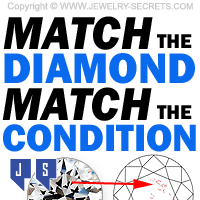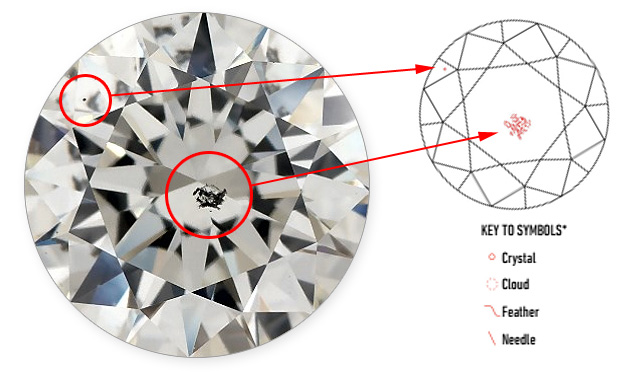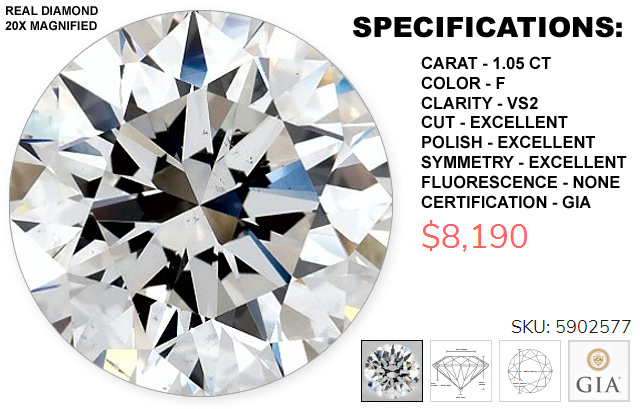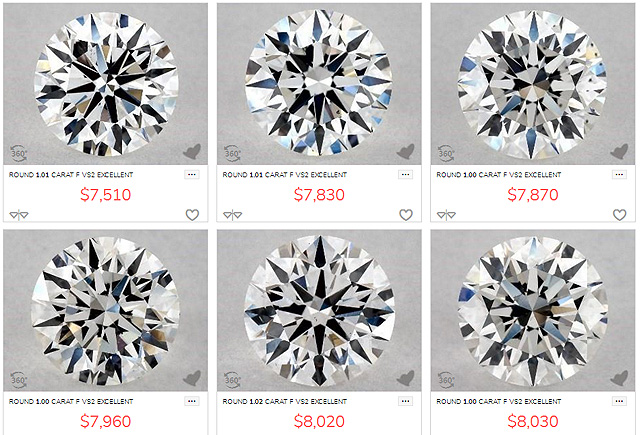MATCH THE DIAMOND, MATCH THE CONDITION
BUYING A DIAMOND BASED UPON A REPORT ONLY CAN BE COSTLY!
This post contains affiliate links. If you use these links to buy something I may earn a commission. Thanks! As an Amazon Associate I also earn from qualifying purchases.

So many people do this (so often it’s frightful). They buy a diamond looking for only 3 things:
- Certification
- Clarity
- Color
Nothing else!
People hear that “A stone MUST be certified…“, which is true for most part, but then they are fine with buying any diamond as long as it has a diamond report, or some official document papers with it.
Then they look at clarity, “eye-clean“; SURE! And the color “white?“; YES! And they are totally happy and satisfied with their choice.
But this way of shopping is wrong and you could end up with a diamond that’s not worth its value.
This is because there are many more things to consider when buying a diamond, other than the most popular 3 (and that’s not the top 3 either – the top 3 would be; cut, certification, sparkle). Price is a combination of many attributes that can make one stone thousands of dollars different from another. Even of the same carat weight.
Things like:
- Who certified the diamond?
- What’s the cut grade?
- Does the diamond have fluorescence?
- Does the diamond sparkle?
- Did you compare stones side by side?
- Did you view the diamond under a microscope?
- Did you match the diamond to the report?
- Is the diamond in the same condition as reported?
All huge points…
And points that could be very, very costly.
Buying a diamond is easy. Getting a report with it is easy. Buy did you even realize that if you don’t compare the report to the diamond, view it under 10x magnification, and match the inclusions on the plot to the actual stone… it may not even be the right diamond, or right report.
Isn’t that scary?
You have to view and match the inclusions as best as you can. Inclusions are a fingerprint, and no two are identical.
Like this diamond here…
| CARAT, CLARITY, COLOR, CUT, POL, SYM, FLUOR | PRICE | VIEW |
| 1.01, SI2, K, EX, EX, EX, FAINT | $3,180 | VIEW |
Looking at that diamond above, and looking at the diamond plot (a diagram of the flaws as shown on a diamond report), you can safely say “YES, THOSE MATCH!” Undoubtedly!
But it doesn’t stop there…
What if this diamond (hypothetically speaking) was chipped after the report was made? (and the date on the report is March 27, 2018) If it was, the report wouldn’t show that chip. It would still consider this diamond an SI2. But if it were chipped then the damage would change the clarity grade of this stone (because chips and cracks are considered a flaw). It would probably drop the clarity rating of this diamond down a couple of notches (as well as the value and price). So if you didn’t look at the stone, view it under a microscope, and see that the condition was the same, or changed… You’d never know it.
Usually if a report is newer, like created in the last year or so, that diamond will be fine (even though there are exceptions to this rule, of course). But if the report is older, like 10-20 years old… Then be cautious. Make sure you scope the stone and look all around the facets, girdle and culet. Older reports often mean that the stone was traded-in, exchanged, upgraded, sold, bought, previously owned… And that means, it probably has been worn, and may have chips or damage!!!
Older reports always deserve more scrutiny
And to know if a report is older… Check the date. Every diamond report is dated. Easy as that (so if you just opt for newer dated reports, you won’t have to worry).
Fractures and chips are common in lower clarity diamonds (like I clarity stones). So if you view a diamond that’s higher clarity, like this VS2, F…
| CARAT, CLARITY, COLOR, CUT, POL, SYM, FLUOR | PRICE | VIEW |
| 1.05, VS2, F, EX, EX, EX, NONE | $4,360 | VIEW |
And you notice that the diamond is fractured… It’s not the same condition. Not the same clarity. Not the same value.
It’s important to view the full report (and please, only purchase GIA certified diamonds), and verify the flaws and condition…
Because a diamond can look good on paper, but not in real life.
Looking closer is protecting yourself!
Look at every diamond before you buy it. View it closeup. From all sides and angles. See the stone. See the sparkle. Read the report.
Otherwise, you could learn the hard way.
See some more incredible VS, Colorless diamonds HERE at James Allen (their prices are awesome).
Cheers! :)

















Leave a comment